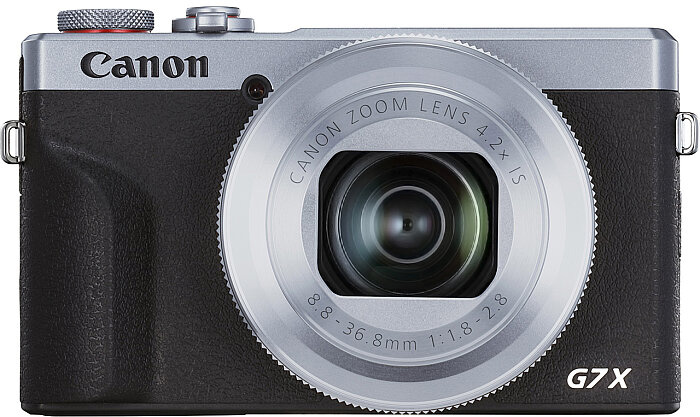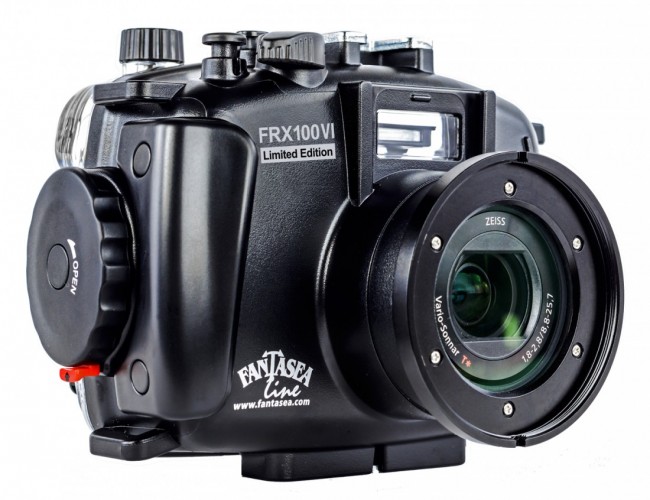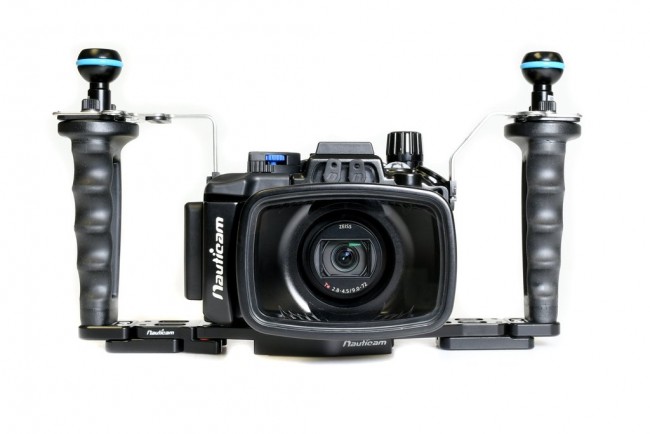Sony RX100 VII vs. Canon G7X III – Top Compact Cameras For Underwater
Sony and Canon have been leading the market for several years now, with their excellent high-end compact cameras – the Canon G7X series and the Sony RX100 series. These compacts are ideal for underwater photography thanks to their small size and superb image quality.
The newest additions to those line-ups are the Sony RX100 VII and the Canon G7X Mark III. In the following article we’ll compare those two models to help you make the smartest choice when getting your next camera setup.

The Sony RX100 VII
Sony’s newest RX100 camera is built on the success of the 6 models that preceded it. Sony has been consistently making excellent cameras using the same formula that has worked for them since 2012 – Excellent quality in an ultra compact size.
The Sony RX100 VII, like its predecessors, is a very small, travel friendly 1″ sensor compact camera. The most significant change that Sony has introduced is the longer 24-200mm zoom lens, which we’ve seen on the RX100 VI and carries on to the RX100 VII as well. For land photographers, this is nothing but great – more zoom, same size camera. For us underwater photographers, this is somewhat of a caveat.
As we explained in our overview of the RX100 VI, the longer lens is more difficult to support underwater, requiring a longer port. Naturally, some compromises have to be made – support the longer zoom and lose some wide angle compatibility, or leave the port short and miss out on some of that zoom. More about this further down the article.
The Sony RX100 VII is a masterpiece of engineering. With both phase-detection and contrast-detection focus points, it focuses faster and more accurately than any other camera in the market. Video capabilities include 4K and high speed slow motion video, as well as highly advanced video features usually reserved for professional cameras.
Image quality, low light capabilities and color reproduction are stunning. It’s pretty much the best compact camera currently in the market.

Canon G7X Mark III
Canon have been competing with Sony on the throne for the best high-end compact camera for years. While Sony was quick to release more and more models, Canon remained consistent with a new model every 2-3 years. The original G7X was a direct response to Sony’s first couple of RX100 cameras and held up fairly well.
Canon has been offering an excellent high-end compact at a much more down-to-earth price tag, without compromising on featured and quality.
The Canon G7X III sells for almost half the price of its Sony counterpart. It offers 4K video at 30fps, 1080p at 120fps for nice and smooth slow motion video, excellent image quality thanks to the 20MP stacked CMOS sensor and Digic 8 processor.
Canon continues using the same 24-100mm lens, which is actually now an advantage compared to Sony and easier to support for underwater. Keep in mind that before Sony’s lens change, Sony was actually much more compatible with wide angle wet lenses compared to Canon, but now it’s the other way around.
Important note – When the Canon G7X Mark III was initially released, it had a MAJOR focus flaw. It simply would not focus or took ages to do that. Canon have quickly released a firmware updated that has completely resolved this issue. The G7X III now focuses perfectly as it should, even faster than the G7X Mark II. You might still encounter older reviews before the firmware upgrade was released. They are no longer relevant.
Specification Comparison
| Canon G7X Mark III | Sony RX100 Mark VII | |
|---|---|---|
| MSRP (US$) | $749 (as of Mar 2020) | $1298 (as of Mar 2020) |
| Sensor / MP | 1.0″ inch (0.52″ x 0.35″) – 20.1MP | 1.0″ inch (0.52″ x 0.35″) – 20.1MP |
| Lens | 24 – 100mm F1.8 – F2.8 (x4.2 zoom) | 24 – 200 mm F2.8 – 4.5 (x8.3 zoom) |
| Max Video Quality | 3840 x 2160p (4K): 30 fps, 1920 x 1080p: 120 fps, 60fps, 30fps | 3840 x 2160p (4K): 30 fps, 25 fps, 24 fps (proxy video 720p) 1920 x 1080p: 120fps. HFR – 1920 x 1080p (Super Slow Motion) 250 fps, 500 fps, 1000 fps |
| ISO | 125-12800 (expands to 25600) | 80-12800 (expands to 25600) |
| Max Shutter Speed | 1/25600s (Electronic Shutter) | 1/32000s (Electronic Shutter) |
| Screen Resolution | 3.0″ LCD (1,040,000 pixels) | 3.0″ LCD (921,600 pixels) |
| Touch Screen | Yes | Yes |
| Battery Life (CIPA) | 235 (320 with Eco mode) | 260 (Stills), 40-70 min (movie) |
| Shoots RAW | Yes | Yes |
| Continuous Shooting | 20 fps in Raw format | 30 fps in raw format |
| Underwater White Balance | Yes | Yes |
| Minimum Focus Distance | 1.97″ (5cm) (Wide) – 1.31′ (40cm) (Telephoto) | 3.15″ (8cm) (Wide) – 3.28′ (1m) (Telephoto) |
| Dimensions | 4.2 x 2.4 x 1.7″ / 105.5 x 60.9 x 42.0 mm | 4.0 x 2.3 x 1.6″ / 101.6 x 58.1 x 41.0 mm |
Underwater Housings
Both the Sony RX100 VII and the Canon G7X Mark III have plenty of housings available for them. You can either get an affordable and excellent value Fantasea / Ikelite housing, or opt for a high end Nauticam / Sea & Sea aluminum housing. A major difference between the housings is the ability to change ports. Changing ports will allow you better support for wet lenses, but will also require more fussing around with accessories and higher risk of floods.
For a detailed summary check out these posts:
Best Underwater Housing for Sony RX100 series
Best Underwater Housing for Canon G7X Mark III
Photo Samples
Coming soon…
Usability
Both the Canon and the Sony allow full manual controls, which is crucial for great underwater photography. Thanks to the small and simple design, all controls are within reach, so operating the cameras even inside the housing is a breeze.
Actually, some topside photographers complain that the RX100 and G7X series are too small, slipping out of their hands and making it hard to find the buttons without looking. For us underwater photographers using them in a housing – no problem! 🙂
The housing actually makes them exactly at the right size to comfortably hold in your hand and reach all controls.
Generally Canon make a slightly more user friendly interface, with controls easier to adjust and menus easier to comprehend and navigate through.
Wet Lenses
It’s quite common to extend the range of underwater compacts with wet lenses – either wide angle or macro diopters. Compatibility with various wet lenses can vary, depending on the housing you are using and the camera’s lens.

Both cameras work great with macro diopters. There’s an advantage to the Sony thanks to its 200mm lens, which results in more magnification when using a diopter and longer working distance. This used to be Canon’s advantage back when Sony had a 24-70mm lens.
As for wide angles, the new Sony lens presents a challenge. Since it extends out further, housing manufacturers had to support with it a longer port. That means that any lens you mount outside will be positioned further from the camera lens, resulting in more vignetting and softer corners.
Fantasea solved this problem by creating a short port, similar to the one used for the Sony RX100V and prior. This supports the wide angle lenses perfectly, but limits the zoom to 66mm, which means you cannot utilize the full potential of the camera for macro. That being said, 66mm is still enough for decent macro shots ( as you can see in our reviews of previous Sony RX100 cameras ).
Ikelite and Nauticam solved the long port issue by using their interchangeable port system and offering a short port that can replace the standard port. This port should be exclusively used for wide angle wet lenses and doesn’t support zoom.
Note – Zooming with a short port:
If you try to zoom in with a short port or with the Fantasea housing beyond what’s allowed, the lens will bump into the port, the camera will indicate a lens error and shut down. No harm done.
The advantages of having interchangeable ports is of course better wet lens support and ideal optical quality when shooting wide angle.
The cons are:
- Pricier setup – need to get 2 ports.
- Less versatility underwater – being “stuck” with one port.
- More o-rings to maintain and housing more susceptible to floods.
There is no right choice, it really depends on what type of photography you plan to shoot more and what you’re willing to compromise on.
Bottom Line
Whichever camera you choose – Sony or Canon, you will NOT be disappointed. These are both wonderful imaging tools. Paired with the right accessories and with proper guidance on how to use them properly, you can get stunning results with either one!
The Sony has the upper hand in terms of image quality and focus speed. If you’re looking to get the best compact out there – Sony RX100 VII is exactly that. Keep in mind that the new lens limitations may be a good reason to get the older models, such as the RX100 VA (The RX100V’s replacement with minor upgrades). We absolutely love the RX100 V / VA and still think it’s one of the top choices for underwater photographers even today with 2 newer models in the market.
Canon is more affordable, leaving you more budget for important accessories such as strobes and lenses. If you’re on a tight budget and willing to spend up to $1500 USD, the better choice would be the Canon bundle + strobe kit, rather than just the Sony bundle. A strobe is far too important to pass on.
If you’re upgrading from a previous Canon or Sony, you might shorten your learning curve by sticking to the same brand, so that you don’t have to relearn all the settings once again. Unless you have a good reason to switch.
If you’re still unsure about which one to choose, or which housing to get for your camera, reach out to us via the online chat! We love helping out.
Feel free to ask any questions on this post that might be relevant for fellow divers as well.
- Native Lenses vs. Wet Lenses for Underwater Photography – December 20, 2023
- The Complete Guide to Practicing at Home for Underwater Photographers – October 4, 2023
- Best Strobe for Underwater – The Ultimate Strobe Guide (Updated!) – June 29, 2023

 CAD
CAD






3 comments
Hi Ran, cab you also tell something about the video performance for both of them?
My understanding from many reviews on the g7 x mark iii autofocus issue is that while the firmware upgrade did fix the issue for stills, it is still junk and fuzzy/jumpy for video. Are you saying that this is not the case?
Hey Jim,
To be honest, I haven’t tested it out myself yet.
However, from test videos online and feedback from users, the AF is quite satisfactory and works great after the firmware upgrade.
See this video with some great tests: https://www.youtube.com/watch?v=smwidAOTxDk
I look forward to testing it when diving opens up again!